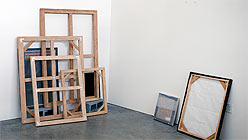2. In a contemporary moment of hard, sexy minimalism, I like to see an artist who isn’t afraid to get a little messy and neurotic. For her Cowboy Project, Katelyn Eichwald covered two walls in a dark, narrow hallway with a collection of small drawings, collages, and paintings. Some pieces are directly ripped from her notebooks, and everything was hung in a dense salon style using thin strips of masking tape. The overall effect is frenzied and aggressive; one had the sense that Eichwald needed to extricate the artworks from her body with tremendous urgency, as in a state of exorcism. The text, which litters the pieces, only adds to its cryptic wildness (i.e. ‘swollen knuckles’ and ‘he looks forward to the white light.’)

3. The show’s curator Glen Helfand described Cara Levine’s piece Thunder Looks Like This as a “homemade thunder machine.” Indeed, the elegant, unadorned sculpture, made using poplar and oak wood and a wide steel sheet, creates a low, resounding boom when agitated. The simple elegance of the object, and its almost-functional purpose of emulating a natural phenomenon that is heard and not in fact seen, summons up a spiritual feeling. Kneeling before the object to shake it on a small, velvet pillow, I had the distinct sense of worshipping at a shrine.

4. Kate Bonner’s monotone digital photographic prints mounted to MDF board are immaculate. And with titles like Among other things and One or two things, they are also totally mysterious and withholding. The color-tinted prints appear to have originally been Xeroxes of specifically curated and arranged personal objects. The photographs are cleanly mounted to angular, shaped MDF boards, a material that usually has a clunky, heavy effect, but feels totally weightless suspended on the gallery walls and slumped in its corners. The work borders on being too trendy, but is ultimately so peculiar, well crafted, and excellently arranged that it’s hard not to be drawn to its side.

5. Kate Nartker’s woven animations are exactly what they sound like: a series of narrative videos comprised of still photographs of woven fabric, shifting and evolving in pattern from one shot to the next to animate motion. As ambitious and impressively laborious as those videos are, Nartler’s two light box sculpture/photographs, titled Skins, moved me the most. Operating in the same conceptual framework as the videos, each features multiple photographs printed on sheer fabric, layered atop one another on knee-high light box tables. The images — perhaps personal, familial images — are slightly askew, and the effect mimics an off-register digital photograph, or an accidental moray pattern. Nartker’s work is haunting in its mysterious luminosity, and its purposeful inaccuracies.

6. Here is the full title of Liam Everett’s piece, too good to clip for the sake of space: The report and/or variable prayer, for the sake of which, or in order to, throw the dogs a flexible bone outside of a not-so-feasible-language that could only become a way for being, and of which, is demonstrated through the constraints and limitations of a practice of practice. I am not sure what it means or from where it’s derived, but I have a guess: Everett’s pieces, freestanding wooden structures draped in dyed silks and surrounding a hanging mobile, are minimal and playful, and as much about the endgame of material process as its tools (hence a “a practice of practice”). It would be wonderful to see this work, which seems like it is designed to blow in a gentle zephyr, installed in the great outdoors.
The 2012 CCA MFA Thesis Exhibition runs through May 19, 2012 at thePotrero Hill campus in San Francisco. For more information visit cca.edu.








